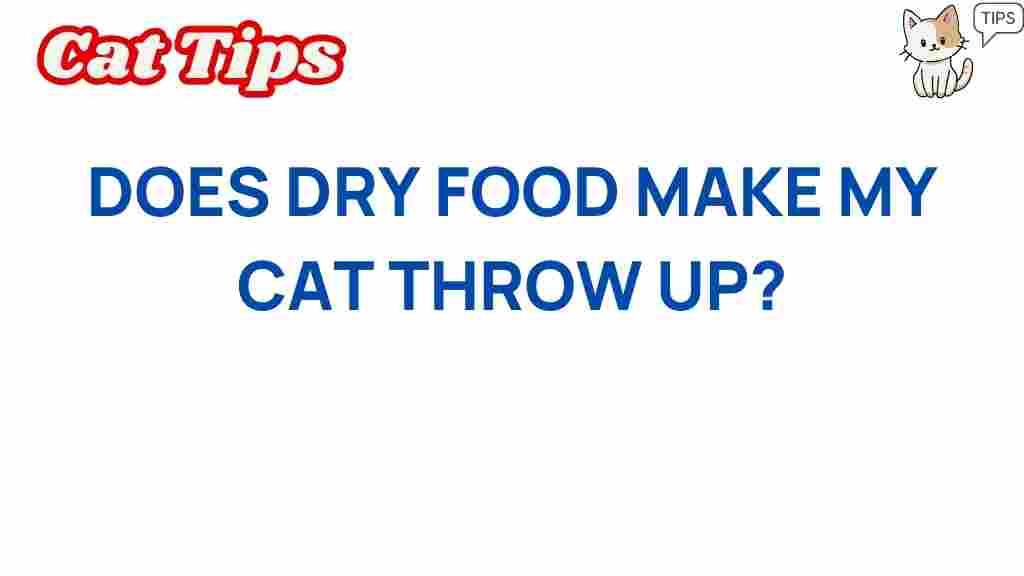The Surprising Truth: Does Dry Food Make My Cat Throw Up? | Cat Health
As a cat owner, ensuring your feline friend’s well-being is a top priority. One common concern that many cat parents face is the issue of their cats throwing up after eating. If you’ve ever wondered, “Does dry food make my cat throw up?” you’re not alone. In this article, we will delve into the surprising truth about dry cat food, its impact on cat health, and what you can do to prevent vomiting in your pet.
Understanding Cat Health and Nutrition
Before we can answer whether dry food is the culprit behind your cat’s vomiting, it’s essential to understand the relationship between diet and cat health. Nutrition plays a critical role in your cat’s overall well-being, and the type of food you choose can significantly impact their digestive system.
- **Protein:** Cats are obligate carnivores, meaning they require a diet high in protein.
- **Fat:** Healthy fats are vital for energy and nutrient absorption.
- **Carbohydrates:** While not essential, some carbohydrates can provide energy.
- **Vitamins and Minerals:** Essential for various bodily functions.
When it comes to dry food, it typically contains a higher carbohydrate content compared to wet food, which can affect your cat’s digestion. Understanding how these components interact with your cat’s unique digestive system is crucial.
Why Do Cats Vomit?
Vomiting is a common issue in cats and can occur for various reasons. Identifying the cause is crucial for effective treatment and prevention. Here are some common reasons why cats vomit:
- **Hairballs:** Cats groom themselves frequently, leading to hairballs that can irritate the stomach.
- **Dietary Indiscretion:** Cats sometimes eat things they shouldn’t, leading to upset stomachs.
- **Food Sensitivities:** Some cats may have sensitivities to certain ingredients in their food.
- **Health Issues:** Conditions like gastroenteritis, kidney disease, or parasites can also cause vomiting.
Does Dry Food Contribute to Vomiting?
Now that we have a basic understanding of cat health, let’s explore whether dry food is a contributing factor to your cat’s vomiting. The truth is, dry food can play a role, but it is not the sole cause. Here are some important points to consider:
1. Ingredient Quality
The quality of ingredients in dry cat food can significantly affect your cat’s digestive health. Low-quality foods may contain fillers, artificial preservatives, and by-products that can irritate your cat’s stomach. Always choose high-quality brands that prioritize natural ingredients.
2. Eating Habits
How your cat eats can also affect their likelihood of vomiting. Rapid eating, or “wolfing down” food, can lead to vomiting. Consider these tips to help your cat eat more slowly:
- **Use a puzzle feeder:** These feeders require cats to work for their food, slowing them down.
- **Smaller meals:** Offer smaller, more frequent meals throughout the day.
3. Hydration
Dry food has a lower moisture content than wet food, which can lead to dehydration if your cat is not drinking enough water. Dehydration can contribute to digestive issues, including vomiting. Always ensure your cat has access to fresh water, and consider incorporating wet food into their diet to increase hydration.
4. Food Sensitivities
Some cats may develop sensitivities to specific ingredients, such as grains or certain proteins. If you suspect your cat has a food sensitivity, consult your veterinarian. They may recommend an elimination diet to identify the offending ingredient.
Step-by-Step Process to Address Vomiting
If your cat is vomiting frequently, it’s essential to take a systematic approach to address the issue. Here’s a step-by-step process:
Step 1: Observe Your Cat’s Behavior
Keep track of when your cat vomits. Note the following:
- **Time of day:** Is it after meals, or does it happen randomly?
- **Frequency:** How often does your cat vomit?
- **Appearance of vomit:** What does it look like? Is there hair, food, or other material present?
Step 2: Evaluate Their Diet
Check the ingredients in your cat’s dry food. Ensure it is high-quality and free from fillers. Consider switching to a different brand if you suspect the current one is causing issues.
Step 3: Adjust Feeding Practices
Implement changes to your cat’s feeding routine to promote better eating habits. This can include:
- Using puzzle feeders to slow down eating.
- Providing smaller, more frequent meals.
Step 4: Increase Water Intake
Encourage your cat to drink more water. You can:
- Provide a pet water fountain, as many cats prefer running water.
- Incorporate wet food into their diet.
Step 5: Consult Your Veterinarian
If vomiting persists despite these changes, it’s time to consult your veterinarian. They can conduct a thorough examination and may recommend tests to identify underlying health issues.
Troubleshooting Tips
In addition to the steps outlined above, here are some troubleshooting tips to help you manage your cat’s vomiting:
- **Monitor for Hairballs:** If hairballs are frequent, consider grooming your cat regularly or using hairball control products.
- **Avoid Table Scraps:** Human food can upset your cat’s stomach; stick to their regular diet.
- **Check for Changes:** Any sudden changes in diet or environment can stress your cat and lead to vomiting.
- **Keep Calm:** Stress can impact your cat’s health. Provide a calm environment to help reduce anxiety.
Conclusion
In conclusion, while dry food can contribute to vomiting in some cats, it is not the sole cause. Understanding the components of your cat’s diet, their eating habits, and their hydration needs are essential for maintaining optimal cat health. By taking a proactive approach and consulting with your veterinarian when necessary, you can help ensure your feline friend stays happy and healthy.
For more information on cat health and nutrition, check out this helpful resource. Remember, a well-informed pet owner is a responsible pet owner!
This article is in the category Health and created by CatTips Team
